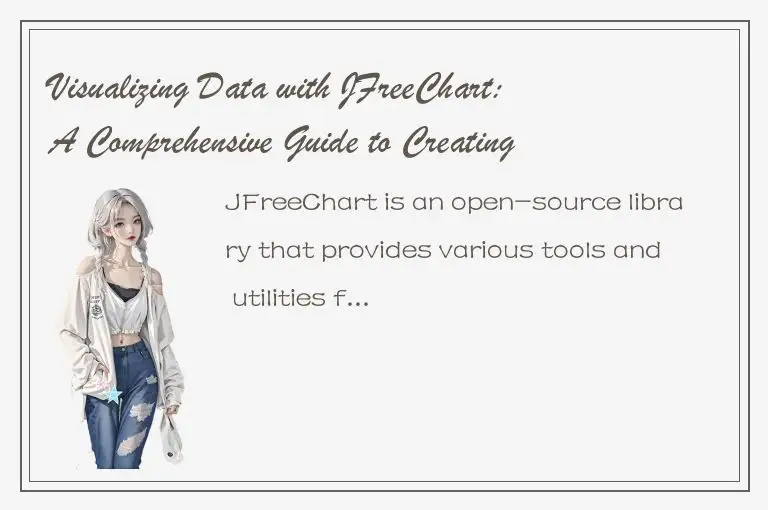JFreeChart is an open-source library that provides various tools and utilities for creating interactive and dynamic charts and graphs. It has been widely used in data analysis, marketing research, and other fields where information visualization is crucial. This article will provide a comprehensive guide to creating stunning charts and graphs using JFreeChart.

What is JFreeChart?
JFreeChart is a Java-based library that assists developers in creating high-quality charts and graphs for displaying data in various formats. It provides an extensive range of chart types, including line charts, bar charts, pie charts, time series charts, scatter plots, candlestick charts, and more.
Moreover, JFreeChart lets developers customize their charts and graphs to meet their specific requirements. You can change colors, fonts, layouts, and images within the charts and graphs.
Why use JFreeChart?
The primary reason for using JFreeChart is its ability to help developers to visualize complex data sets in an easy-to-understand format. It enables decision-makers to quickly analyze the data for better decision-making, which is helpful in most industries, including finance, health, research, and many more.
Another reason to use JFreeChart is that it is a free, open-source library, which makes it accessible and affordable to all developers. It provides an array of tools required to create simple to complex charts, which eliminates the need to create charts from scratch.
Getting Started with JFreeChart
To get started with JFreeChart, you need to install the library first. You can download the latest version of JFreeChart from the project's website, jfree.org. After downloading, extract the zip file and add the jar files to your Java project's classpath.
JFreeChart is dependent on two other open-source libraries, i.e., iText and Object Refinery Utility Library (ORU). Therefore, you also need to download these libraries and add them to your project's classpath.
Once the installation is complete, you can start creating charts and graphs. Let's now take a look at some of the critical chart types and how to create them using JFreeChart.
Line Chart
A line chart is ideal for showing trends in data over time. To create a line chart using JFreeChart, perform the following steps:
1. Create a data set.
```
DefaultCategoryDataset dataset = new DefaultCategoryDataset();
dataset.addValue(20, "Sales", "Jan");
dataset.addValue(60, "Sales", "Feb");
dataset.addValue(50, "Sales", "Mar");
dataset.addValue(70, "Sales", "Apr");
```
2. Create a chart object.
```
JFreeChart chart = ChartFactory.createLineChart(
"Sales Report", // Chart title
"Months", // X-axis label
"Sales ($)", // Y-axis label
dataset, // Dataset
PlotOrientation.VERTICAL,
true,
true,
false
);
```
3. Create a chart panel.
```
ChartPanel chartPanel = new ChartPanel(chart);
```
4. Add the chart panel to your UI component, e.g., JPanel.
```
JPanel panel = new JPanel();
panel.add(chartPanel);
```
Bar Chart
A bar chart is ideal for comparing data across different categories. To create a bar chart using JFreeChart, perform the following steps:
1. Create a data set.
```
DefaultCategoryDataset dataset = new DefaultCategoryDataset();
dataset.addValue(20, "Sales", "Jan");
dataset.addValue(60, "Sales", "Feb");
dataset.addValue(50, "Sales", "Mar");
dataset.addValue(70, "Sales", "Apr");
```
2. Create a chart object.
```
JFreeChart chart = ChartFactory.createBarChart(
"Sales Report", // Chart title
"Months", // X-axis label
"Sales ($)", // Y-axis label
dataset, // Dataset
PlotOrientation.VERTICAL,
true,
true,
false
);
```
3. Create a chart panel.
```
ChartPanel chartPanel = new ChartPanel(chart);
```
4. Add the chart panel to your UI component, e.g., JPanel.
```
JPanel panel = new JPanel();
panel.add(chartPanel);
```
Pie Chart
A pie chart is ideal for showing the percentage of a whole. To create a pie chart using JFreeChart, perform the following steps:
1. Create a data set.
```
DefaultPieDataset dataset = new DefaultPieDataset();
dataset.setValue("Sales", 30);
dataset.setValue("Expenses", 45);
dataset.setValue("Profit", 25);
```
2. Create a chart object.
```
JFreeChart chart = ChartFactory.createPieChart(
"Sales Report", // Chart title
dataset,
true,
true,
false
);
```
3. Create a chart panel.
```
ChartPanel chartPanel = new ChartPanel(chart);
```
4. Add the chart panel to your UI component, e.g., JPanel.
```
JPanel panel = new JPanel();
panel.add(chartPanel);
```
Conclusion
In conclusion, JFreeChart is a powerful data visualization tool that can handle a wide range of chart types. It enables developers to represent large datasets in an understandable format, which helps in decision-making.
This article demonstrated how to create some of the most popular chart types using JFreeChart. However, the library provides many more features and chart types. We recommend going through the project's documentation and exploring its capabilities thoroughly.




 QQ客服专员
QQ客服专员 电话客服专员
电话客服专员